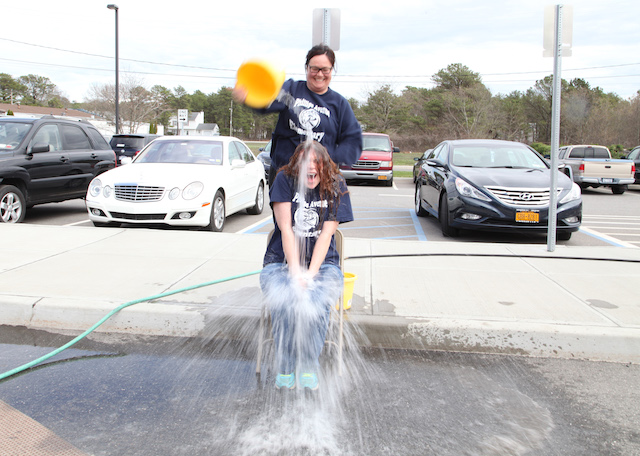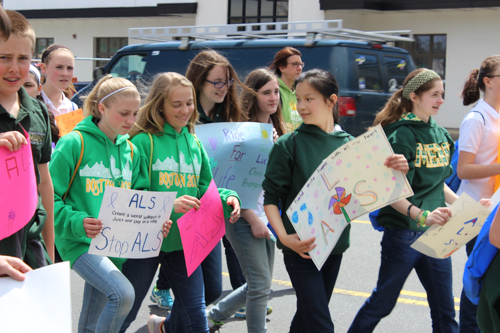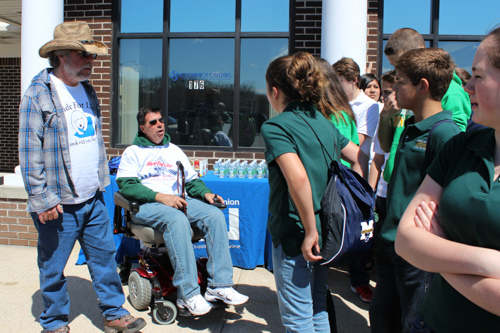When ALS victim Chris Pendergast first began his annual “Ride for Life” across Long Island 18 years ago, most members of the general public wouldn’t even recognize the name of the deadly, incurable and extremely rare disease that would eventually leave him completely paralyzed.
But a viral social media phenomenon last summer made ALS a household name after millions of people started filming themselves pouring buckets of ice water over their heads to raise money and awareness for the cause.
“This disease has been called hopeless,” said Paul Weissman, an ALS patient from Bohemia who is participating in the Ride for Life this year. “But the Ice Bucket Challenge has brought us a lot of hope.”
The terms of the challenge, for those who somehow missed the flood of videos across their Facebook and Twitter feeds, were for people to pour buckets of ice water over their heads or to donate $100 to the ALS Association, a national non-profit that provides support for those who suffer from the disease and funds research dedicated to finding a cause and a cure. Those who posted videos then had to nominate five of their friends to take on the challenge.

It caught on like wildfire. Though the campaign was criticized by some as “slacktivism,” it raised more than $220 million worldwide. In the month of August 2014 alone, the ALS foundation doubled the amount of donations it received during the entire 2013 fiscal year.
“The research is going strong now because of the Ice Bucket Challenge,” said Frank Verdone, a Miller Place doctor and ALS patient who also participated in the Ride for Life today. “They’re doing huge stuff, things they never had the money to do before.”
ALS, also known as Lou Gehrig’s disease after the Yankees first baseman whose career ended abruptly after his diagnosis, is a progressive neurodegenerative disorder during which victims slowly lose control of their muscles, speech and, eventually, breathing. There is no known cause for 90 to 95 percent of cases.
“There’s no rhyme or reason to it,” said Weissman. “Nobody knows the cause. Nobody has found a cure. That’s why we need the money for the research.”
ALS most commonly strikes people between the ages of 40 and 70, drawing no racial, ethnic or socioeconomic boundaries, according to the ALS Association website. It’s slightly more common in men than in women, with an average survival rate between three to four years.

Pendergast, who can now only speak in a hoarse, barely audible whisper, began the Ride for Life in 1998, five years after he was diagnosed with the disease. The trek spans across the island, beginning today in Greenport and ending on May 9 at Washington Square Park in Manhattan.
Pendergast is able to tackle his annual journey using a motorized wheelchair, which he controls using movements of his head. He can breathe only through a respirator, but he is still alive, against all odds and for reasons that no one can explain. He is one the disease’s longest survivors.
“I look at Chris, and that is my hope,” Weissman said. “I was told I only have three to five years to live, and that was two years ago.”
“They told me two to three years,” said Verdone, who is in a wheelchair. “I’m one year out now, and I hope to be here 22 years later, like Chris. They can say what they want, but I don’t believe them.”
ALS progresses in each patient differently, but for Weissman, it’s an “upper body thing.” It began in his right hand two years ago, but he now has no use of his right arm and very limited use of his left. Verdone, who is wheelchair-bound, has no use of his legs. Another patient participating in the walk this year, Clinton Meyer of Northport, has trouble swallowing and speaking, but still has use of his upper and lower body.
“It’s bizarre how it affects everyone in different ways,” Weissman said.
But thanks to the enormous surge of donations last year, ALS research has been making great strides.
Up until very recently, Verdone explained, researchers could only test drugs on mice genetically modified to have ALS.
“Unfortunately, it just didn’t hold over on the human models,” Verdone said. “So anything they were testing on mice really wasn’t working for us.”
With new funding, however, researchers this year are now taking skin cells from ALS donors and transforming them into brain cells naturally afflicted with the disease. “So they’re actually testing drugs on human ALS nerve cells,” Verdone said. “Now we have a whole new avenue to test.”
The Ride For Life makes a stop every year at McGann-Mercy High School, where Pendergast graduated in 1966. McGann-Mercy High School students presented Pendergast with a $1,500 check this morning at Teachers Federal Credit Union, a sponsor of this year’s Ride for Life.
The students, teachers and marchers then made their way to Riverhead Town Hall, and finally to Phillips Avenue Elementary School, where teachers did an Ice Bucket Challenge of their own. Phillips Avenue also raised $1,000 for ALS.
“The students gave up their ice cream money for the week to donate to ALS as well,” said Sandra Kolbo, Riverhead Central School District public relations director.

Both Weissman and Verdone said that raising awareness for the disorder has given them “a purpose” as they fight a disease that is, for now, incurable.
“Let’s face it,” Weissman said. “We’re told to go home, get our stuff together, and prepare to die. I could easily lay on the couch, pull the covers over my head, and wait for the bad stuff to happen. Well, all that stuff is going to happen anyway, so I might as well fight. And by fighting, I mean live,” he added. “Take each day, take each moment, and make a memory.”
Verdone, who gave up his medical practice in September, said that without activism, “I would lose my mind. I was used to working basically seven days a week,” he said. “And now I go around with Chris to the schools and talk to people about the disease and raise awareness.
“The message goes beyond just ALS,” Verdone said. “It’s to never lose hope, to always defy the odds. Be optimistic.”
“That’s the message we want to get across,” Weissman said.
The survival of local journalism depends on your support.
We are a small family-owned operation. You rely on us to stay informed, and we depend on you to make our work possible. Just a few dollars can help us continue to bring this important service to our community.
Support RiverheadLOCAL today.
































